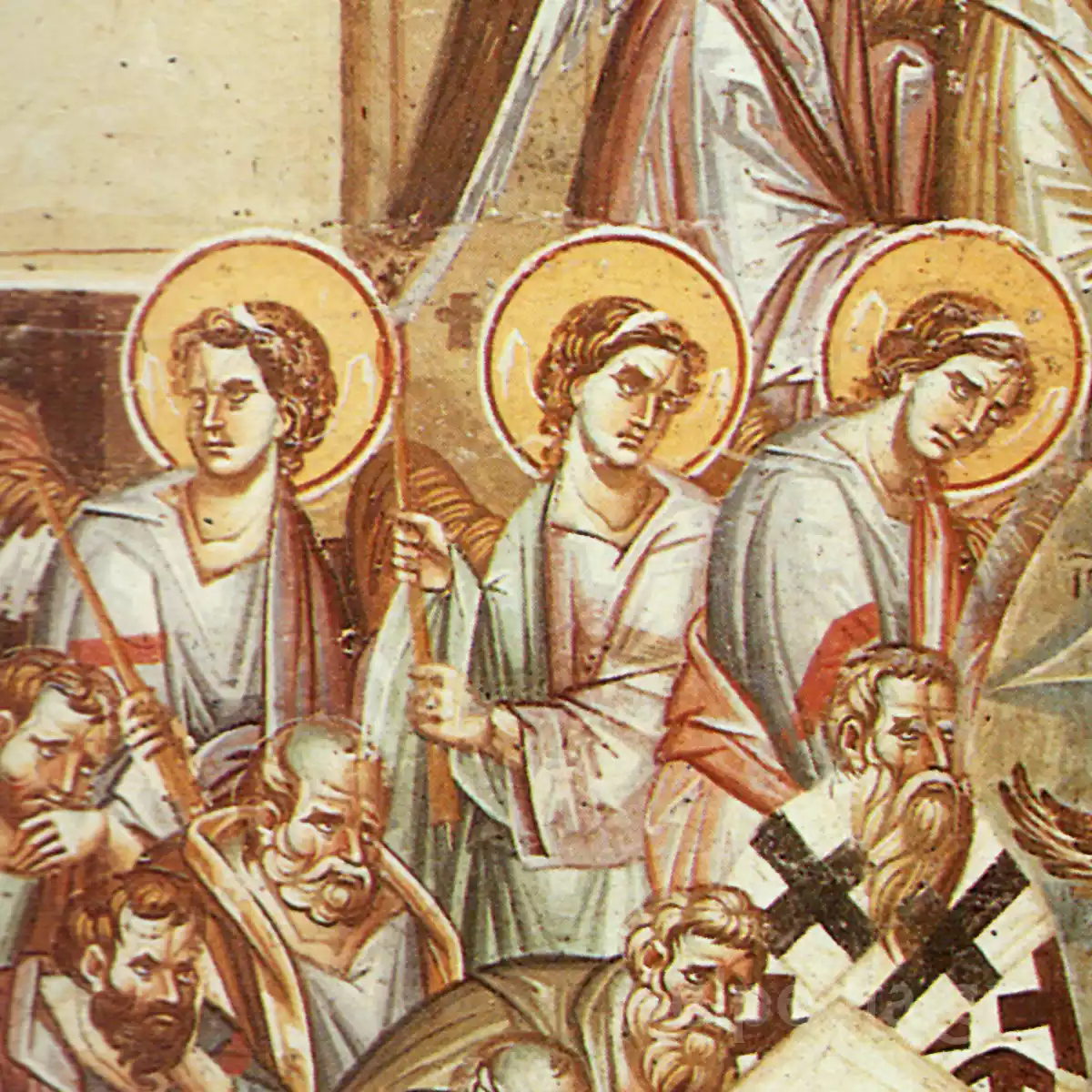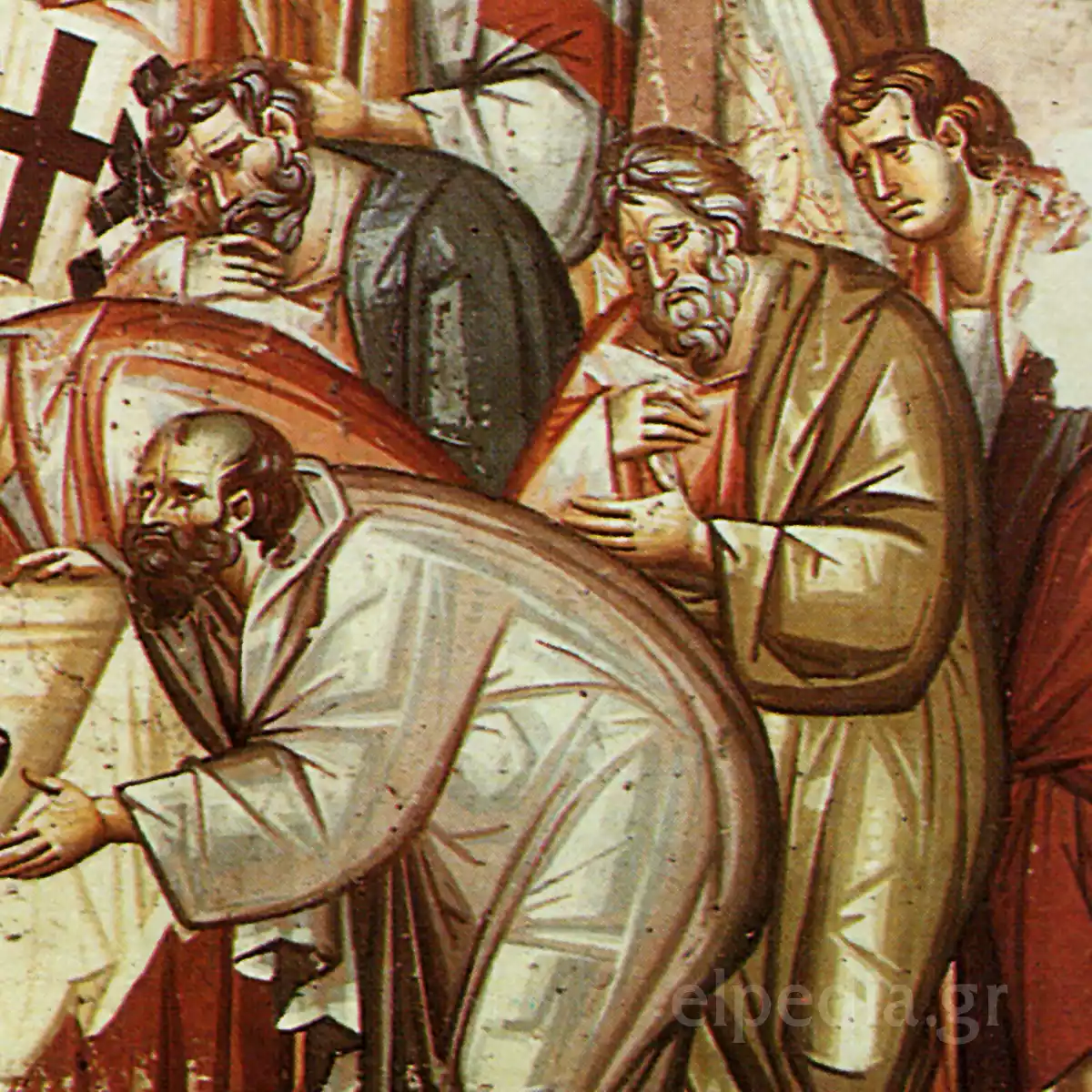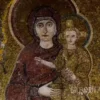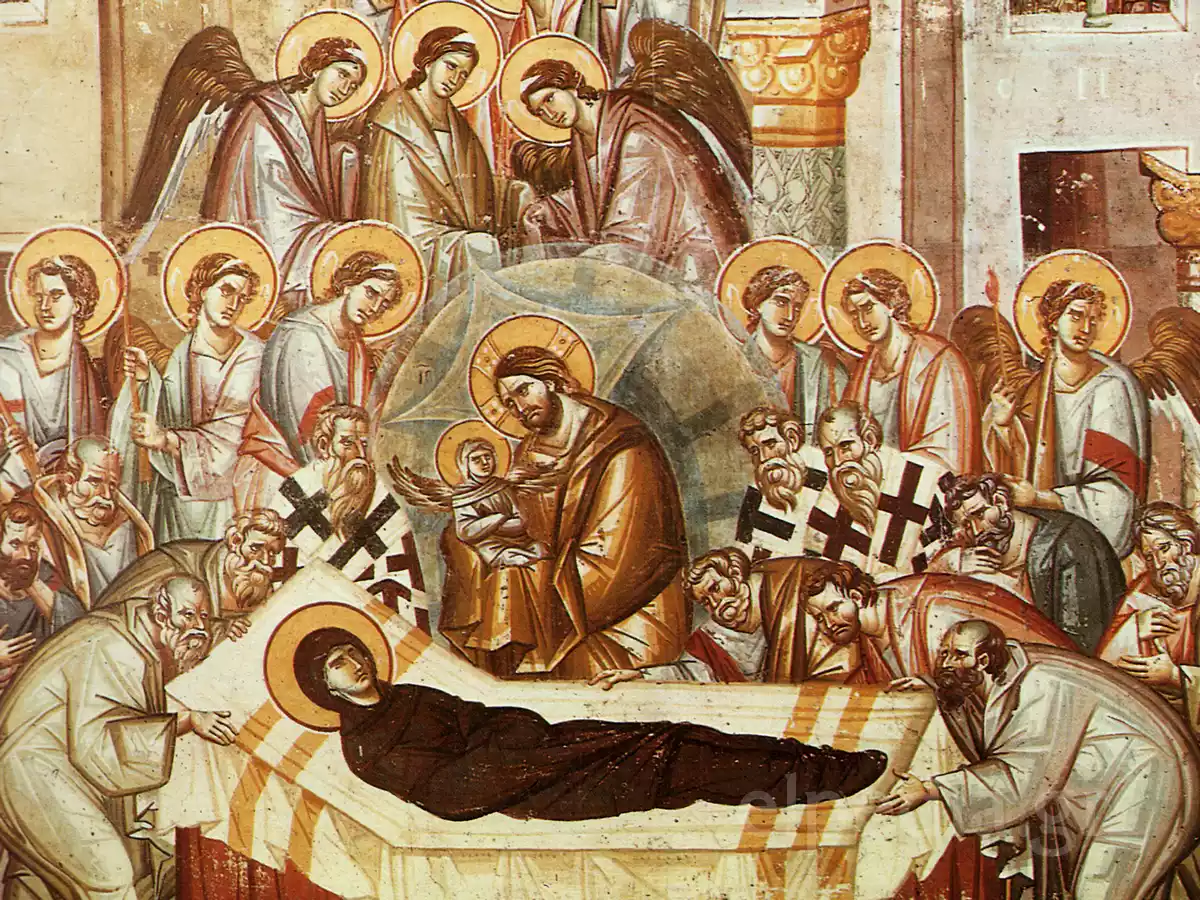
The impressive fresco of the Dormition of Theotokos in Ohrid (1294/95) is one of the masterpieces of the Paleologan period, distinguished for its complexity and symbolism
Title: The Dormition of Theotokos
Artists: Michael Astrapas and Eutychios
Type: Fresco
Date: 1294/95
Materials: Fresco
Location: Church of the Virgin Mary Peribleptos (today Saint Clement), Ohrid, North Macedonia
The fresco of the Dormition of Theotokos in the church of the Virgin Mary Peribleptos in Ohrid is one of the most significant examples of Byzantine monumental painting of the late Paleologan period. Created by the renowned Thessalonian painters Michael Astrapas and Eutychios in 1294/95, the composition impresses with its monumental dimension, complexity, and expressive power. Located on the western wall of the church, the fresco culminates a cycle of five scenes that narrate the heavenly departure of the Virgin Mary.
The work is a characteristic example of Paleologan art, with the artists combining the established iconographic tradition with innovative elements. At the center of the composition, the Virgin Mary lies on the deathbed, surrounded by the sorrowful apostles and Christ holding the soul of his mother. The depiction of the heavenly dimension of the event is striking, with a multitude of angels descending in order from the heavenly dome, while the architectural structure of the depth with the imposing buildings enhances the monumentality of the scene.
The significance of the fresco lies both in its artistic perfection and its theological dimension, as it projects the doctrine of salvation and the mediating power of Theotokos. It also serves as a historical document, as the full donor inscription is preserved, mentioning the sponsors, the great benefactor Progonos Sgouros and his wife Eudokia, providing valuable information about the socio-political conditions of the time (search for “medieval iconography of Theotokos”).

The orders of angels descend orderly from heaven, creating an impressive gradation in the composition of the Dormition of Theotokos in Ohrid
The Church of the Virgin Mary Peribleptos in Ohrid
Architecture and historical context
The church of the Virgin Mary Peribleptos in Ohrid, known today as Saint Clement, is an exceptional example of Byzantine church architecture of the 13th century. It is a four-column cross-in-square church with a dome and narthex, following one of the most widespread architectural types of the middle and late Byzantine period. The ecclesiastical art of the region of Macedonia presents particular interest, as it combines elements from the artistic centers of Constantinople and Thessaloniki with local traditions.
The church was built during a critical period for the Byzantine Empire, when the Palaiologos emperors were trying to reconstruct the state after the recovery of Constantinople from the Latins in 1261. This historical context is reflected in the art of the time, characterized by a renewed interest in the classical tradition and a tendency towards expressiveness and narrativity. (Search for more information with the word: Byzantine art of the Palaiologos)
The sponsors and the donor inscription
The Peribleptos has the exceptional privilege of preserving complete details about the time of creation and the contributors to its decoration through the donor inscription of 1294/95, which is located above the main entrance. According to this, the sponsors of the church were the great benefactor and son-in-law of the king Progonos Sgouros and his wife Eudokia. The title of “great benefactor” was a high office in the Byzantine administrative system, indicating the social and political significance of the church.
The sponsorship of monumental works of art by members of the aristocracy was a common practice in Byzantium, expressing both the piety and the social prestige of the sponsors. The Peribleptos bears witness to the existence of strong local elites in the region of Ohrid, who maintained close ties with the Byzantine imperial court.
The position of the Dormition in the iconographic program
The fresco of the Dormition of Theotokos occupies a prominent position on the western wall of the church, being one of the largest compositions of the iconographic program. This choice is not random, as the western wall is symbolically connected with the end of earthly life and the entrance to eternity.
The Dormition in Peribleptos represents the culmination of a cycle of five scenes that narrate the heavenly departure of Theotokos. This narrative approach is characteristic of the Paleologan period, where there is an increase in narrativity and the number of depicted episodes from the lives of saints and the major feasts of the Church. To the left of the central scene, the angel of the Lord is depicted announcing to the Virgin Mary her impending end, while she bids farewell to her friends. To the right, the exit takes place, and the apostles find the tomb empty after the Assumption of Theotokos, thus completing the narrative sequence of events.
The creators of the work and their artistic identity
The Thessalonian painters Michael Astrapas and Eutychios are among the most important artists of the Paleologan period. Their collaboration is well documented, as they have signed many frescoes in Peribleptos, either by writing their full names or their initials. Their activity extends to other churches in the area, demonstrating the esteem they enjoyed from the powerful sponsors of the time.
Their artistic style is characterized by expressive skill, narrative richness, and exceptional technical mastery. Influenced by the artistic tradition of Thessaloniki, the second most important artistic center of the empire after Constantinople, they combine in their work the monumental character of Byzantine art with innovative elements that foreshadow the developments of late Byzantine painting.

The composition of the Dormition of Theotokos in Ohrid is organized in levels that connect the heavenly with the earthly world, expressing the Byzantine worldview
Analysis of the Dormition Fresco
The central scene and its symbolic dimension
At the center of the composition of the Dormition of Theotokos in Ohrid is the deathbed of the Virgin Mary, with her body lying on a white shroud with golden stripes. Christ stands at the center behind the bed, shining in golden-rose garments, holding in his hands the soul of his mother, which is presented as a miniature of Theotokos wrapped in swaddling clothes. Of particular interest is the addition of wings to the soul of the Virgin Mary, an element that reflects Hellenistic influences in Byzantine frescoes.
The posture of Christ creates a vertical axis that connects heaven with earth, symbolizing the mediation of Theotokos between the divine and the human world. The Dormition is not merely depicted as a mournful event, but as a triumph of the Incarnation and a substantial affirmation of salvation. (Search for more information with the word: Byzantine iconography of the Dormition of Theotokos)
The angelic ranks and the heavenly hierarchy
A striking element of the composition is the depiction of the angelic orders descending from heaven in order and sequence. The angels are presented in endless rows, creating a tiered arrangement that enhances the sense of depth and perspective. Some hold lit candles, honoring “the mother of eternal light,” an element that adds both symbolic dimension and lighting tensions to the composition.
This heavenly arrangement is one of the most original compositional solutions of the artists and reflects the influence of the Paleologan perception of the hierarchical organization of the heavenly world. It has been observed that the depiction of angels in Byzantine frescoes of the period follows specific patterns associated with pseudo-Dionysian angelology, where the angelic orders are structured into nine choirs.
The details and secondary scenes
Beyond the central scene, the fresco is enriched with secondary narrative details that enhance its theological and symbolic dimension. In the depiction on the right of the composition, an angel raises a sword to punish the irreverence of Jephonias, an episode derived from the apocryphal narratives of the Dormition. This scene adds a dramatic tone to the composition and serves as a warning for the faithful.
In the background of the fresco, the apostles are seen coming “from afar,” transported through clouds from the ends of the earth to attend the Dormition, while in the upper right corner, Theotokos is depicted offering her belt to the apostle Thomas who was delayed in arriving. This inclusion of different temporal moments in a single composition is characteristic of Byzantine iconography, which sought to convey the theological fullness of the event rather than a realistic chronological sequence.
The architectural depth and spatial organization
Of particular interest is the architectural structure of the depth with the imposing buildings that frame the scene. The buildings are presented with tall cubic volumes and elaborated details, delineating the space and creating a framework that enhances the monumentality of the composition. In the windows, female figures can be seen observing the event with expressions of sorrow.
The architectural elements in the Byzantine frescoes of Peribleptos are not merely decorative features, but create symbolic spaces that support the theological interpretation of the scene. In this specific case, the buildings can be interpreted as a reference to the earthly Jerusalem, while the arched depiction of the sky at the top of the composition symbolizes the heavenly Jerusalem, thus creating a dialectical relationship between the two worlds.
Technical and stylistic characteristics of the work
From a technical perspective, the fresco of the Dormition in Ohrid impresses with its exceptional quality of execution. The artists have achieved a remarkable balance between the necessary strictness of the Byzantine iconographic tradition and a renewed expressiveness that characterizes the Paleologan renaissance. The color palette is dominated by ochres, earthy tones, and bright colors for the garments, while the golden halos of the saints add a spiritual glow to the composition.
The physiognomies of the figures are rendered with detail and expressive power, with particular emphasis on the portrayal of emotions. The drapery of the garments testifies to the technical skill of the painters and follows the Paleologan trend for rich, fluid draperies that highlight the corporeality of the figures without undermining their spiritual character.

Christ holds in his hands the soul of Theotokos in a touching depiction of the transcendence of death. Detail from the Dormition of Theotokos in Ohrid
Conclusion
The fresco of the Dormition of Theotokos in Ohrid is one of the highest achievements of Byzantine art, reflecting the spirituality and artistic genius of the Paleologan period. The work of Michael Astrapas and Eutychios transcends the limits of a simple religious depiction, transforming into a stunning visual theology that addresses the relationship between the divine and the human, life and death, heaven and earth.
This particular fresco is not merely a historical document or an artistic achievement; it is a living spiritual monument that continues to move and teach, highlighting the unbroken continuity of the Byzantine tradition in Orthodox spirituality. In seeking the dialogue between art and faith, we find in the Dormition of Ohrid an eternal example of the human effort to depict the ineffable and to understand the transcendent.
The apostles around the deathbed of the Virgin Mary in the fresco of the Dormition in Ohrid
Frequently Asked Questions
What period is the fresco of the Dormition of Theotokos in Ohrid dated to?
The fresco of the Dormition in the church of the Virgin Mary Peribleptos in Ohrid is accurately dated to the years 1294/95, thanks to the preserved donor inscription located above the main entrance of the church. This dating places it in the period of the Palaiologos dynasty, which is considered the last significant period of flourishing Byzantine art before the fall of Constantinople to the Ottomans in 1453.
What are the distinctive features of the Byzantine depiction of the Dormition in the church of Ohrid?
The Dormition of Theotokos in Ohrid is distinguished by its extremely complex composition with the ranks of angels descending from heaven, the architectural structure of the depth, and the incorporation of multiple temporal moments into a single scene. A particular innovation is the depiction of the soul of Theotokos with wings, an element that combines Byzantine and Hellenistic influences, as well as the impressive use of color and perspective.
Who were the artists who painted the Dormition of Theotokos in Peribleptos of Ohrid?
The creators of the fresco were the Thessalonian painters Michael Astrapas and Eutychios, who signed their work with their names or initials in various representations of the church. They are considered among the most important painters of the Paleologan period, and their activity extends to other churches in the wider area, demonstrating the recognition they enjoyed from the powerful sponsors of the time.
What does the scene of the Dormition of Theotokos symbolize in Byzantine art of Ohrid?
In the Byzantine perception, the Dormition of Theotokos is not merely the depiction of her death, but symbolizes the victory over death and the transition from earthly to heavenly life. In the fresco of Ohrid, this theological perception is expressed through the presence of Christ receiving the soul of his mother and the multitude of angels participating in the event, marking the union of the earthly with the heavenly.
What is the significance of the church of the Virgin Mary Peribleptos where the fresco of the Dormition of Theotokos is located?
The church of the Virgin Mary Peribleptos, known today as Saint Clement, is one of the most important Byzantine monuments of Ohrid and the wider Balkans. Built with the sponsorship of the great benefactor Progonos Sgouros and his wife Eudokia, the church is distinguished for its complete iconographic program and the exceptional quality of its frescoes, making it an important center for the study of Byzantine art and theology.

The apostles express their sorrow around the bed of Theotokos. The scene exudes emotion and spirituality in the fresco of Ohrid
Bibliography
- Drandakēs, Nikolaos V. 1995. Byzantine frescoes of the Middle Mani.
- Franses, Rico. 2018. Donor Portraits in Byzantine Art: The Vicissitudes of Contact Between Human and Divine.
- Grabar, André. 1998. The Byzantine iconoclasm.
- NA, NA. 2015. Early Byzantine Churches in Macedonia & Southern Serbia.
- Papadopoulos, Stelios. 1998. Holy Monastery of Pantokrator: icons.
- Yiannias, John J. 1994. The Byzantine tradition after the fall of Constantinople.


